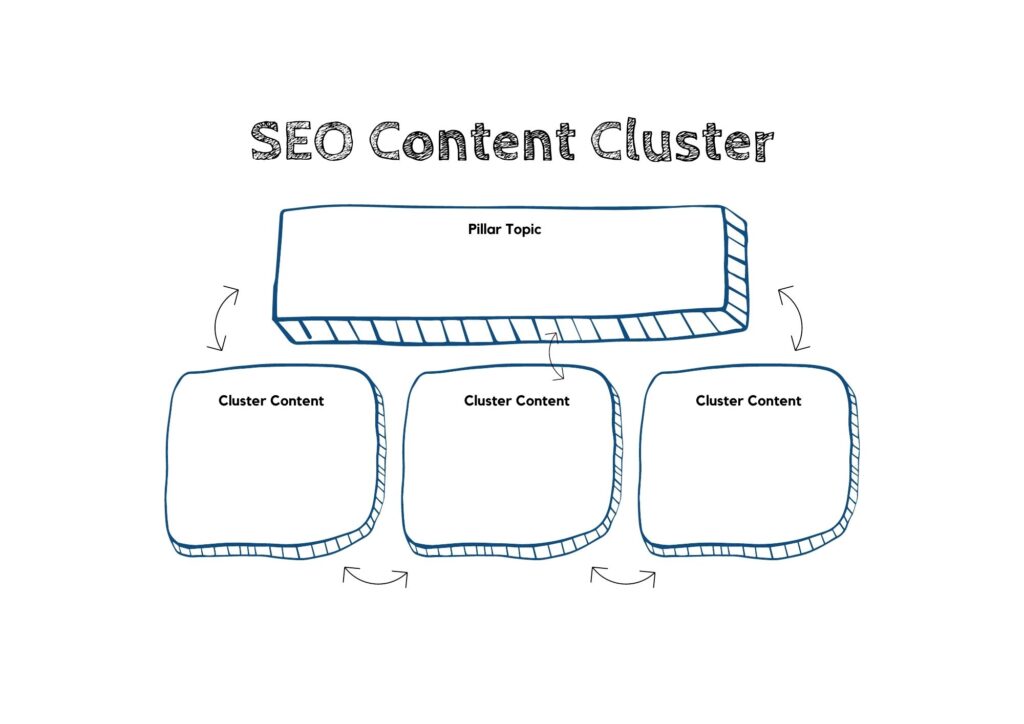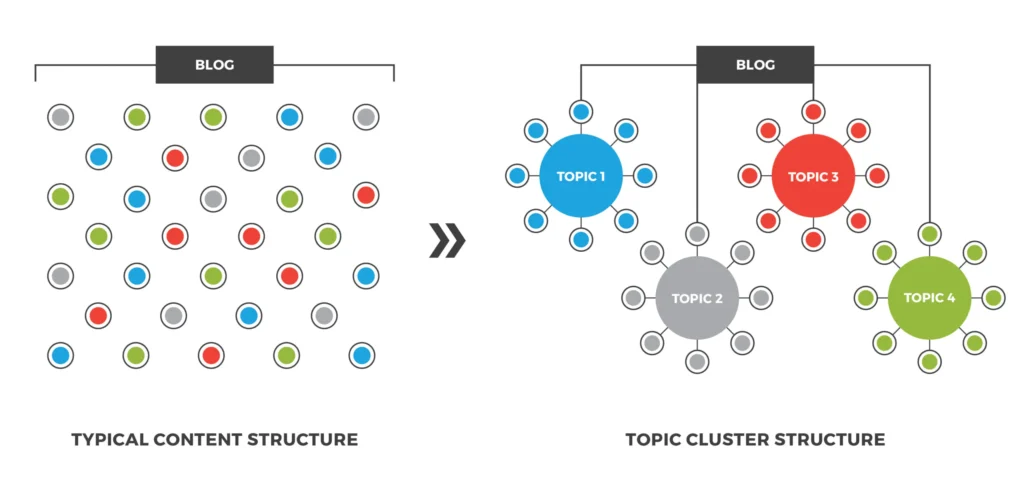In the fast-paced world of SEO, ranking for competitive keywords requires more than just publishing standalone blog posts. To win in 2025 and beyond, smart marketers are building content clusters—strategic webs of interlinked content that establish topical authority, boost organic visibility, and support long-term SEO growth.
This article will walk you through what content clusters are, why they work, and how to build an effective cluster strategy that drives consistent traffic and rankings over time.
What Is a Content Cluster?

A content cluster, also known as a topic cluster, is an SEO strategy where multiple pieces of content are organized around a central topic (the “pillar”) and linked together. The cluster structure typically looks like this:
- Pillar Page: A comprehensive, high-level guide targeting a broad keyword (e.g., “Email Marketing”).
- Cluster Content: Supporting articles that cover subtopics in depth (e.g., “Best Email Subject Lines,” “Email List Segmentation,” “Email Automation Tools”).
All cluster pages link back to the pillar page (and often to each other), creating a tightly connected structure that signals authority on the topic to search engines.
Why Content Clusters Work for SEO
✅ 1. Topical Authority
Google favors sites that demonstrate comprehensive knowledge of a subject. By covering a topic from multiple angles, clusters show depth and expertise—key components of E-E-A-T (Experience, Expertise, Authoritativeness, and Trustworthiness).
✅ 2. Improved Internal Linking
Clusters naturally lend themselves to internal linking, which distributes link equity, helps crawlers index pages, and guides users to related content.
✅ 3. Keyword Coverage
Pillar and cluster content allow you to target a mix of broad and long-tail keywords, increasing your chances of ranking for a wide variety of search queries.
✅ 4. Better User Experience
When users find comprehensive content on your site that answers related questions, they stay longer, explore more, and are more likely to convert.
How to Build a Content Cluster Strategy

1. Choose a Core Topic
Start with a high-level topic that aligns with your business goals and has solid search demand. This will become your pillar page.
- Example: If you run a digital marketing agency, a good pillar topic might be “Content Marketing Strategy.”
Use SEO tools like Ahrefs, SEMrush, or Google Keyword Planner to validate search volume and competition.
2. Map Out Cluster Topics
Break down your core topic into subtopics that users are likely to search for. These become your cluster articles.
For “Content Marketing Strategy,” subtopics might include:
- How to Create a Content Calendar
- Content Marketing for B2B vs. B2C
- Best Tools for Content Planning
- Measuring ROI of Content Marketing
Aim for 8–15 supporting articles per pillar, depending on the topic’s depth.
3. Conduct Keyword Research
Each cluster piece should target a unique long-tail keyword related to the pillar topic. Look for:
- Moderate to low competition
- High relevance to the main topic
- Intent-matching queries (informational, transactional, etc.)
Group keywords by intent and funnel stage to create a balanced cluster.
4. Create the Pillar Page
The pillar should be a long-form, definitive guide on the topic. It should:
- Be 2,000+ words (if the topic warrants it)
- Provide a broad overview with links to deeper cluster articles
- Target a high-volume keyword
- Use clear subheadings and structured formatting (H2s, H3s, bullets)
Example title: The Ultimate Guide to Content Marketing Strategy in 2025
5. Write Cluster Content
Each cluster article should:
- Dive deep into a specific aspect of the pillar topic
- Target one main keyword
- Link back to the pillar page with relevant anchor text
- Optionally link to other related cluster articles
Ensure consistent voice, style, and formatting across all cluster content.
6. Interlink Strategically
This is the glue that holds your cluster together. Link:
- From cluster pages → to the pillar (using keyword-rich anchors)
- From pillar page → to cluster pages (as contextual references or in a table of contents)
- Between cluster articles → when relevant to reinforce topical relationships
This structure helps both users and search engines navigate your content more effectively.
7. Publish & Promote
Once your content cluster is live:
- Submit to Google Search Console for indexing
- Share across social channels, newsletters, and communities
- Reach out to industry partners or influencers for backlinks
- Monitor performance and update content periodically
Tools That Help with Content Cluster Planning
- Surfer SEO & Clearscope: Identify keyword gaps and topic opportunities
- Ahrefs Content Explorer: Find semantically related topics and questions
- SEMrush Topic Research: Visualize topic clusters and subtopics
- Notion / Trello / Airtable: Organize your cluster map and publishing workflow
- Screaming Frog: Analyze internal linking once your cluster is live
Examples of Successful Content Clusters

Example 1: HubSpot’s “Marketing” Hub
- Pillar: What is Marketing?
- Clusters: Content Marketing, Email Marketing, Social Media Marketing, etc.
- Result: HubSpot ranks on page one for nearly every major marketing keyword.
Example 2: Healthline’s “Intermittent Fasting” Cluster
- Pillar: Intermittent Fasting 101
- Clusters: Benefits, Side Effects, Schedules, Foods to Eat
- Result: Dominates the topic with multiple SERP appearances.
Best Practices for Long-Term Growth
- Update clusters regularly: Refresh outdated stats, links, and examples.
- Add new cluster pages as trends emerge: Keep your content ecosystem growing.
- Use structured data (schema): Improve search visibility with FAQ, HowTo, or Article markup.
- Monitor performance: Use Google Analytics and Search Console to see which pages drive traffic—and why.
- Optimize for featured snippets and People Also Ask (PAA): Write clearly structured answers to common questions.
Final Thoughts
In 2025, SEO isn’t just about keywords—it’s about topics, structure, and relationships. Content clusters provide a scalable framework for building topical authority, capturing long-tail traffic, and creating an ecosystem of content that benefits both users and search engines.
Whether you’re starting from scratch or retrofitting existing content, investing in a solid content cluster strategy will pay long-term dividends in organic growth, engagement, and conversions. The sooner you build your content universe, the faster you’ll become a destination, not just a stop along the way.






